-
Accurate and reliable neutron induced cross-sections of titanium isotopes around the neutron energy of 14 MeV are important for fusion reactor design and related nuclear engineering calculations, as titanium is a vital structural component in the fusion reactor. These cross-sections can reflect the interactional mechanism between target nucleus and incident particles, and provide us with a deep understanding of the nuclear force and structure of titanium. Activation cross-sections of (n,2n), (n,p), and (n,α) reactions of titanium isotopes around the neutron energy of 14 MeV have been measured by many researchers, and they can be found in experimental nuclear reaction data (EXFOR) [1]. The majority of these measurements were acquired before the 1980s, and large discrepancies exist in those data. Moreover, discrepancies exist in the results of different researchers acquired after the 1980s. Thus, it is necessary to conduct the measurements again and more accurately. In the present work, the cross-sections for the 46Ti(n,2n)45Ti,46Ti(n,p)46m+gSc+47Ti(n,d*)46m+gSc[(n,d*)=(n,d)+(n,n+p)],46Ti(n,p)46m+gSc,47Ti(n,p)47Sc+48Ti(n,d*)47Sc,47Ti(n,p)47Sc,48Ti(n,p)48Sc+49Ti(n,d*)48Sc, 48Ti(n,p)48Sc, and 50Ti(n,α)47Ca reactions have been measured in the neutron energy range of 13.5–14.8 MeV with a gamma-ray counting technique using a high-resolution gamma-ray spectrometer and data acquisition system. Pure titanium foils were used as the target material. The reaction yields were obtained by absolute measurement of the gamma activities of the product nuclei using a coaxial high-purity germanium detector. The results measured are compared with past data and with the data verified, as well as the theoretical results.
-
Nuclear reaction cross-sections were obtained by means of activation and identification of the radioactive products. Details were described in numerous publications [2–5]. Here only some salient features are presented that are relevant to present measurements.
Natural titanium foils, whose purity and thickness are 99.99% and 2.98–3.0 mm, respectively, were used to make circular samples with a diameter of 20 mm. They each were placed between thin niobium disks of the same diameter of 20 mm, whose purity is 99.99% and thickness is 1 mm.
Irradiation of the samples was carried out at the K-400 Neutron Generator at the Institute of Nuclear Physics and Chemistry, China Academy of Engineering Physics. Samples were irradiated for 3–7.5 h. The neutrons in the 14 MeV region with a yield of 4 × 1010 n/s to 5 × 1010 n/s were produced by the 3H(d,n)4He reaction with a deuteron beam energy of 255 keV and a beam current of 350 µA. The solid tritium–titanium target used in the generator was about 2.19 mg/cm2 thick. During the irradiation, the neutron flux was monitored by the accompanying α-particles, which were measured with a Au–Si surface barrier detector used in the 135° accompanying a-particle tube, so that corrections could be made for the small fluctuations in the neutron flux. Groups of samples were placed at angles of 0°, 45°, 90°, and 135° respectively, which are relative to the direction of the deuteron beam and centered about the T–Ti target at a distance of 3–5 cm. The neutron energies in the measurements were determined in advance by cross-section ratios for the 90Zr(n,2n)89m+gZr and 93Nb(n,2n)92mNb reactions [6]. The measured neutron energies were 13.5 ± 0.2, 14.1 ± 0.2, 14.4 ± 0.2, and 14.8±0.2 MeV at the irradiation positions of 0°, 45°, 90°, and 135° angles relative to the beam direction, respectively.
After irradiation, the samples were cooled for 28 minutes to 87 hours. The activities of 45Ti,46m+gSc,47Sc,48Sc,47Ca, and 92mNb were measured by a well-calibrated GEM-60P coaxial high-purity germanium (HPGe) detector (crystal diameter 70.1 mm, crystal length 72.3 mm) with a relative efficiency of ~68% and an energy resolution of ~1.69 keV FWHM at 1.33 MeV for 60Co. The samples were measured for 1.5–9.5 h. The efficiency of the detector was pre-calibrated using various standard γ sources. Figure 1 and Fig. 2 show part of the γ-ray spectrum acquired from the titanium samples after a cooling time of about 53 min and 78.73 h, respectively.

Figure 1. (color online) Part of γ-ray spectrum of titanium about 53 m after the end of irradiation.
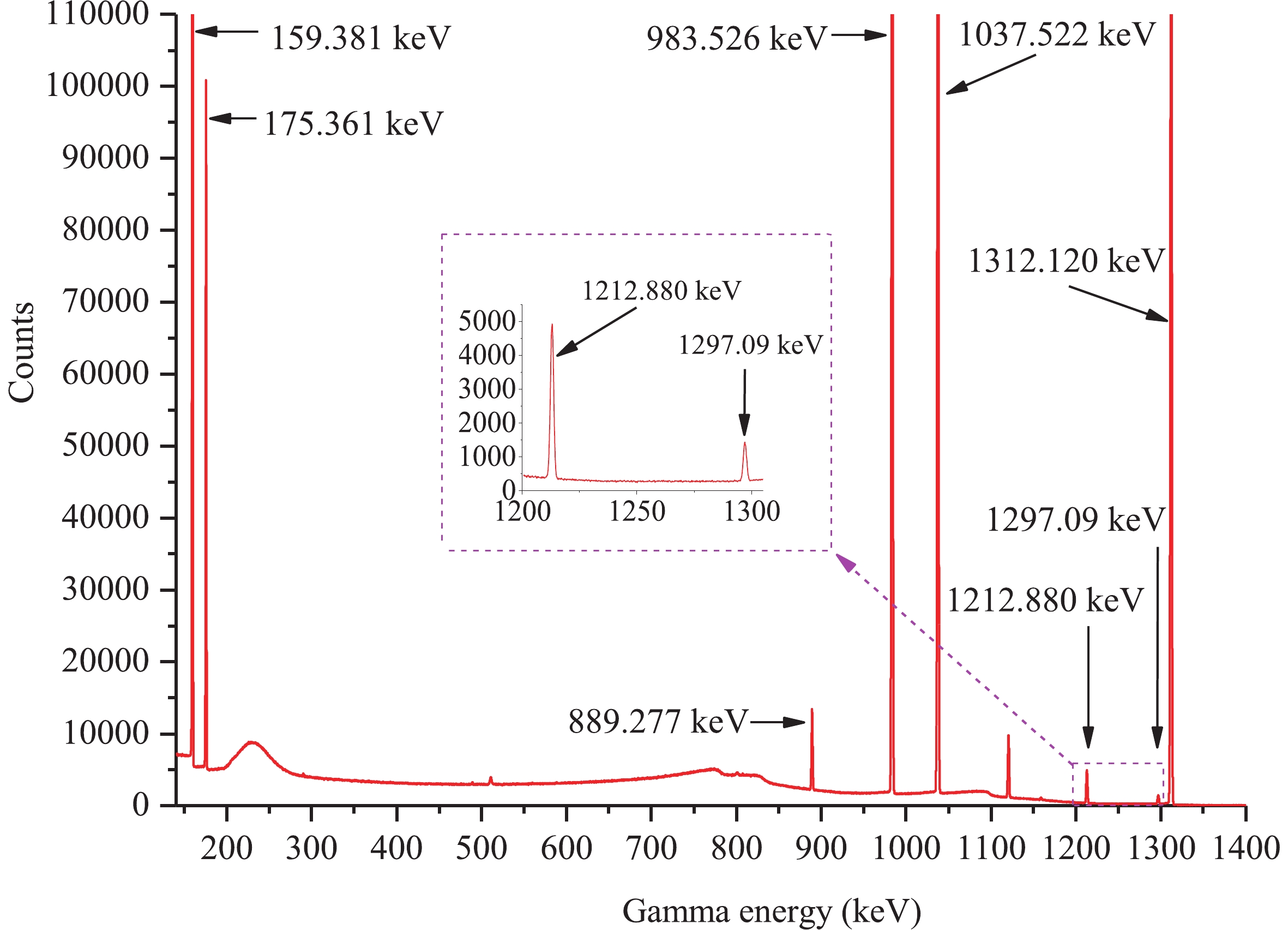
Figure 2. (color online) Part of γ-ray spectrum of titanium about 78.73 h after the end of irradiation.
The associated decay data of all the activation products and the natural abundance of target isotopes under investigation are summarized in Table 1[7]. The abundance of 93Nb comes from Ref. [8], as no abundance of 93Nb is given in Ref. [7].
reaction abundance of target isotope (%) half-life of product Eγ /keV Iγ (%) 46Ti(n,2n)45Ti 8.25 184.8 m 1408.1 0.085 46Ti(n,p)46m+gSc + 47Ti(n,d*)46m+gSc 8.25a 83.79 d 889.277 99.9840 46Ti(n,p)46m+gSc 8.25 83.79 d 889.277 99.9840 47Ti(n,p)47Sc + 48Ti(n,d*)47Sc 7.44a 3.3492 d 159.381 68.3 47Ti(n,p)47Sc 7.44 3.3492 d 159.381 68.3 48Ti(n,p)48Sc + 49Ti(n,d*)48Sc 73.72a 43.67 h 1312.120 100 48Ti(n,p)48Sc 73.72 43.67 h 1312.120 100 50Ti(n,α)47Ca 5.18 4.536 d 1297.09 67 93Nb(n,2n)92mNb 100b 10.15 d 934.44 99.15 aAbundance of target isotope is that of the first mentioned isotope for the 46Ti(n,p)46m+gSc + 47Ti(n,d*)46m+gSc, 47Ti(n,p)47Sc + 48Ti(n,d*)47Sc, and 48Ti(n,p)48Sc + 49Ti(n,d*)48Sc reactions.
bWe used the value given by Ref. [8].Table 1. Reactions and associated decay data of objective activation products.
We calculated the measured cross-sections by means of the equation proposed by Kong et al.[9].
The cross-sections of the 46Ti(n,2n)45Ti, 46Ti(n,p)46m+gSc + 47Ti(n,d*)46m+gSc, 46Ti(n,p)46m+gSc, 47Ti(n,p)47Sc + 48Ti(n,d*)47Sc, 47Ti(n,p)47Sc, 48Ti(n,p)48Sc + 49Ti(n,d*)48Sc, 48Ti(n,p)48Sc, and 50Ti(n,α)47Ca reactions were acquired relative to those of the 93Nb(n,2n)92mNb reaction. The cross-section values of the monitor reaction 93Nb(n,2n) 92mNb were 457.9 ± 6.8, 459.8 ± 6.8, 459.8 ± 6.8 and 459.7 ± 5.0 mb at the neutron energies of 13.5, 14.1, 14.4, and 14.8 MeV, respectively[10]. The results obtained in this work are summarized in Tables 2-6 and plotted in Figs. 3–10. The cross-sections of the 46Ti(n,2n)45Ti, 46Ti(n,p)46m+gSc + 47Ti(n,d*)46m+gSc,46Ti(n,p)46m+gSc,47Ti(n,p)47Sc + 48Ti(n,d*)47Sc,47Ti(n,p)47Sc,48Ti(n,p)48Sc+ 49Ti(n,d*)48Sc,48Ti(n,p)48Sc, and 50Ti(n,α)47Ca reactions around 14 MeV neutron energy have been obtained by about 20, 6, 18, 4, 18, 3, 34, and 14 laboratories, respectively [1]. The previous measurements, whose results were published after 1980, are also summed up in Tables 2–6 and plotted in Figs. 3–10 for comparison. For these reactions mentioned above, their evaluation cross-section curves of JEFF-3.3, CENDL-3.1, ENDF/B-VIII.0 at neutron energies from the threshold to 20 MeV are plotted in Figs. 3-10 for comparison. The theoretical calculation cross-section data at different neutron energies from the threshold to 20 MeV were calculated via the computer code system Talys-1.9 [11–14]. Default values of parameters are adopted in the calculation. The theoretical calculation values at the neutron energies of 13.5, 14.1, 14.4, and 14.8 MeV are also summarized in Tables 2–6 and the theoretical calculation curves plotted in Figs. 3-10 for comparison.
reaction this work literature values En /MeV σ /mb En /MeV σ /mb reference 46Ti(n,2n)45Ti 14.1 ± 0.2 13.3 ± 1.0 (37.8c) 14.7 47 ± 2 [15] 14.4 ± 0.2 37.8 ± 2.8 (54.8c) 14.7 47 ± 2 [16] 14.8 ± 0.2 53.2 ± 3.2 (91.9c) 13.63 0.182 ± 0.029 [17] 13.73 0.894 ± 0.059 [17] 14 8.77 ± 0.48 [17] 14.47 28.9 ± 1.6 [17] 14.72 42 ± 2.3 [17] 15.01 54.9 ± 3 [17] 14.6 51 ± 2 [18] 14.8 33 ± 6.6 [19] 13.5 2.2 ± 0.2 [20] 13.77 7.5 ± 0.6 [20] 14.1 17.7 ± 1.3 [20] 14.39 30.9 ± 2.3 [20] 14.66 42 ± 3.2 [20] 14.78 50.2 ± 3.8 [20] c Theoretical calculation cross-section data obtained from Talys-1.9. Table 2. Summary of the cross section for the 46Ti(n,2n)45Ti reaction around 14 MeV neutron energy.
reaction this work literature values En /MeV σ /mb En /MeV σ /mb reference 46Ti(n,p)46m+gSc + 47Ti(n,d*)46m+gSc 13.5 ± 0.2 289.9 ± 15.1 (212.9 c) 13.447 289.3 ± 10.3 [21] 14.1 ± 0.2 280.6 ± 11.8 (234.3 c) 13.921 296.2 ± 10.7 [21] 14.4 ± 0.2 262.4 ± 11.9 (244.0 c) 14.126 286.8 ± 13.5 [21] 14.8 ± 0.2 251.1 ± 10.6 (255.8 c) 14.347 287.3 ± 11.2 [21] 14.921 292.6 ± 10.9 [21] 14.7 311 ± 7.5 [22] 13.5 306 ± 15 [23] 13.84 286 ± 14 [23] 14.18 299 ± 13 [23] 14.38 305 ± 13 [23] 14.67 294 ± 12 [23] 14.81 305 ± 12 [23] 13.39 305 ± 18 [24] 13.43 312 ± 19 [24] 14.36 299 ± 18 [24] 14.39 294 ± 18 [24] 14.7 304 ± 10 [25] 46Ti(n,p)46m+gSc 13.5 ± 0.2 275.1 ± 14.4 (183.6c) 13.33 274 ± 14 [17] 14.1 ± 0.2 247.8 ± 10.5 (180.9c) 13.56 264 ± 14 [17] 14.4 ± 0.2 218.2 ± 9.9 (163.6c) 13.98 253 ± 13 [17] 14.8 ± 0.2 192.1 ± 8.1 (157.0c) 14.42 240 ± 12 [17] 14.65 234 ± 13 [17] 14.91 210 ± 14 [17] 14.7 261 ± 27 [26] 13.77 302 ± 33 [27] 13.93 291 ± 38 [27] 14.11 302 ± 33 [27] 14.3 298 ± 34 [27] 14.73 298 ± 34 [27] 14.83 267 ± 39 [27] 14.05 267.8 ± 9.3 [28] 13.68 282 ± 13.9 [29] 14.58 284.7 ± 14 [29] 14.8 226.2 ± 22.4 [30] 14.8 266.7 ± 3.2 [31] 13.77 310 ± 33 [32] 13.93 297 ± 38 [32] 14.11 310 ± 33 [32] 14.3 306 ± 37 [32] 14.47 242 ± 33 [32] 14.73 306 ± 34 [32] 14.83 275 ± 39 [32] c Theoretical calculation cross-section data obtained from Talys-1.9. Table 3. Summary of cross sections for 46Ti(n,p)46m+gSc+47Ti(n,d*)46m+gSc and 46Ti(n,p)46m+gSc reactions around 14 MeV neutron energy.
reaction this work literature values En /MeV σ /mb En /MeV σ /mb reference 47Ti(n,p)47Sc + 48Ti(n,d*)47Sc 13.5 ± 0.2 169.3 ± 6.8 (274.2c) 13.447 173.8 ± 4.9 [21] 14.1 ± 0.2 197.6 ± 8.3 (262.3c) 13.921 197.6 ± 5.7 [21] 14.4 ± 0.2 228.0 ± 9.6 (244.3c) 14.126 203.2 ± 5.9 [21] 14.8 ± 0.2 259.6 ± 10.9 (241.2c) 14.347 224.3 ± 6.8 [21] 14.921 267.8 ± 8 [21] 14.7 257 ± 12 [25] 14.1 220 ± 5 [33] + 13.75 164 [34] 13.92 186 [34] 14.11 186 [34] 14.31 192 [34] 14.49 218 [34] 14.76 256 [34] 14.86 271 [34] 47Ti(n,p)47Sc 13.5 ± 0.2 151.0 ± 6.1 (273.0c) 13.33 144.5 ± 9.7 [17] 14.1 ± 0.2 146.9 ± 6.2 (257.5c) 13.56 143.9 ± 9.7 [17] 14.4 ± 0.2 153.3 ± 6.5 (236.5c) 13.98 135.5 ± 9.2 [17] 14.8 ± 0.2 133.6 ± 5.7 (226.0c) 14.42 130.5 ± 8.9 [17] 14.65 127.1 ± 8.7 [17] 14.91 121.5 ± 8.4 [17] 14.7 151 ± 4 [26] 14.73 142 ± 21 [27] 14.83 131 ± 15 [27] 14.6 174.5 ± 13.1 [30] 14.8 169.5 ± 7.0 [31] 14.0 103 ± 10 [35] 14.3 158 ± 9 [36] 14.9 142 ± 12 [36] 14.8 103 ± 10 [37] c Theoretical calculation cross-section data obtained from Talys-1.9. Table 4. Summary of cross-sections for 47Ti(n,p)47Sc+48Ti(n,d*)47Sc and 47Ti(n,p)47Sc reactions around 14 MeV neutron energy.
reaction this work literature values En /MeV σ /mb En /MeV σ /mb reference 48Ti(n,p)48Sc + 49Ti(n,d*)48Sc 13.5 ± 0.2 58.6 ± 2.5 (95.9c) 14.7 68.7 ± 2.1 [25] 14.1 ± 0.2 58.4 ± 2.5 (104.2c) 14.8 73 ± 3.5 [38] 14.4 ± 0.2 60.4 ± 2.6 (108.1c) 14.8 ± 0.2 60.5 ± 2.5 (111.0c) 48Ti(n,p)48Sc 13.5 ± 0.2 58.6 ± 2.5 (95.1c) 13.33 55.3 ± 2.6 [17] 14.1 ± 0.2 58.2 ± 2.5 (102.1c) 13.57 54.7 ± 2.6 [17] 14.4 ± 0.2 60.2 ± 2.6 (104.4c) 13.98 57.8 ± 2.8 [17] 14.8 ± 0.2 60.1 ± 2.5 (104.2c) 14.67 60.4 ± 2.9 [17] 14.93 59.6 ± 2.9 [17] 13.447 63.31 ± 2.23 [21] Table 5. Summary of cross-sections for 48Ti(n,p)48Sc+49Ti(n,d*)48Sc and 48Ti(n,p)48Sc reactions around 14 MeV neutron energy.
Table 5 – continued from previous page reaction this work literature values En /MeV σ /mb En /MeV σ /mb reference 13.921 67.18±2.54 [21] 14.126 63.5±2.42 [21] 14.347 67.75±2.71 [21] 14.921 62.46±2.59 [21] 13.5 61.3±2.8 [23] 13.84 62.4±2.8 [23] 14.18 64.4±2.7 [23] 14.38 65.7±2.7 [23] 14.67 63.5±2.6 [23] 14.81 65.6±2.6 [23] 14.7 76±2 [26] 13.77 51±3 [27] 13.99 53±3 [27] 14.11 55±3 [27] 14.3 55±3 [27] 14.47 55±3 [27] 14.73 60±3 [27] 14.83 58±3 [27] 14.05 58.6±1.8 [28] 13.68 58.7±3.1 [29] 14.36 61.3±3.4 [29] 14.58 62.8±3.2 [29] 14.77 63.4±3.7 [29] 14.8 61.1±6.7 [30] 14.8 71.7±2.7 [31] 13.77 51±3 [32] 13.93 53±3 [32] 14.11 55±3 [32] 14.3 53±3 [32] 14.47 55±3 [32] 14.73 61±3 [32] 14.83 56±3 [32] 14 68±2.6 [33] 14.1 63±2 [33] 14.0 60±4 [35] 14.3 72±3 [36] 14.9 69±6 [36] 14.8 60±4 [37] 14.6 67±4 [39] 14.5 66 [40] 14.66 69.4 [40] 14.8 67.6 [40] 14.85 67.5 [40] 14.9 66.3 [40] 14.8 60±5 [41] c The theoretical calculation cross-section data by using the computer code system Talys-1.9. reaction this work literature values En /MeV σ /mb En /MeV σ /mb reference 50Ti(n,α)47Ca 13.5 ± 0.2 5.75 ± 0.35 (2.01c) 13.35 6.37 ± 0.62 [17] 14.1 ± 0.2 7.94 ± 0.42 (2.51c) 13.58 6.68 ± 0.46 [17] 14.4 ± 0.2 8.46 ± 0.48 (2.97c) 13.99 7.01 ± 0.7 [17] 14.8 ± 0.2 9.47 ± 0.99 (3.53c) 14.68 9.31 ± 0.78 [17] 14.95 10.41 ± 0.88 [17] 13.5 6.6 ± 0.5 [23] 13.84 7.4 ± 0.5 [23] 14.18 8 ± 0.5 [23] 14.38 8.9 ± 0.5 [23] 14.67 9.6 ± 0.5 [23] 14.81 9.5 ± 0.6 [23] 14.7 8.5 ± 0.5 [25] 14.7 11 ± 2 [26] 14.8 9 ± 0.8 [31] 14.6 8.6 ± 0.6 [39] 13.6 6.41 ± 0.68 [42] 13.68 6.54 ± 0.72 [42] 14.1 7.55 ± 0.73 [42] 14.46 8.37 ± 0.75 [42] 14.72 9.22 ± 0.61 [42] 14.86 9.8 ± 0.98 [42] 13.43 6.6 ± 0.5 [43] 14.36 7.9±0.6 [43] c Theoretical calculation cross-section data obtained from Talys-1.9. Table 6. Summary of cross-section for 50Ti(n,α)47Ca reaction around 14 MeV neutron energy.
The complete description of TALYS can be found in the Talys-1.9 manual [11]. TALYS is a computer code system built for the analysis and prediction of nuclear reactions based on physics models and parameterizations [11-13]. It is a versatile tool for the analyses of basic microscopic scientific experiments or for generation of nuclear data for applications. It can simulate nuclear reactions involving neutrons, photons, protons, deuterons, tritons, 3He, and α-particles in the 0.001–200 MeV energy range and for target nuclides of mass of 12 and heavier. To deal with the neutron induced nuclear reactions, we use the optical model. All optical model calculations are performed by ECIS-06 [14], which is implanted as a subroutine in Talys.
The cross-sections of the 46Ti(n,p)46m+gSc + 47Ti(n,d*)46m+gSc reaction were calculated using the equation proposed by Kong et al. [9]. The abundance of the target isotope is equal to that of the first mentioned isotope. The contribution of the 48Ti(n,t)46m+gSc reaction was neglected because of its tiny cross-section (10–7 mb). The cross-sections of the 46Ti(n,p)46m+gSc reaction were computed using the equation proposed by Kong et al. [9], subtracting the contribution of the 47Ti(n,d*)46m+gSc reaction with its evaluated values (16.20, 36.02, 48.40, and 64.61 mb at the neutron energies of 13.5, 14.1,14.4, and 14.8 MeV, respectively) from JEFF-3.3. We ignored the contribution of the 48Ti(n,t)46m+gSc reaction due to its tiny cross-section (10−7 mb).
The cross-sections of the 47Ti(n,p)47Sc + 48Ti(n,d*)47Sc reaction were computed using the same method as above. The contribution from the 50Ti(n,α)47Ca→47Sc decay was subtracted using a formula similar to the one used to reduce the influence of an excited state on the ground state in Ref. [44], and the contribution of the 49Ti(n,t)47Sc reaction was neglected due to its tiny cross-section (on the order of μb). The cross-sections of the 47Ti(n,p)47Sc reaction were computed through the equation proposed by Kong et al. [9] subtracting the contribution from the 50Ti(n,α)47Ca→47Sc decay and the contribution of the 48Ti(n,d*)47Sc reaction with its evaluated values (1.84, 4.77, 7.46, and 12.28 mb at the neutron energies of 13.5, 14.1,14.4, and 14.8 MeV, respectively) from JEFF-3.3. We ignored the contribution of the 49Ti(n,t)47Sc reaction due to its tiny cross-section value (on the order of μb).
The cross-sections of the 48Ti(n,p)48Sc + 49Ti(n,d*)48Sc reaction were also calculated using the same method as above. The contribution of the 50Ti(n,t)48Sc reaction was neglected due to its tiny cross-section (10−9 mb). The cross-sections of the 48Ti(n,p)48Sc reaction were computed by equation proposed by Kong et al. [9], subtracting the contribution of the 49Ti(n,d*)48Sc reaction with its evaluated values (0.60, 1.67, 2.71, and 4.64 mb at the neutron energies of 13.5, 14.1, 14.4, and 14.8 MeV respectively) from JEFF-3.3. We overlooked the contribution of the 50Ti(n,t)48Sc reaction due to its tiny cross-section (10−9 mb).
-
In this study, corrections were made concerning the fluctuation of the neutron flux during the irradiation, γ-ray self-absorption in the sample, and the sample geometry. The uncertainties in our work mainly stem from counting statistics (0.5%–9.6%), standard cross-section uncertainties (1.1%–1.5%), detector efficiency (2.0%), weight of samples (0.1%), sample geometry (1.0%), self-absorption of γ-ray (1.0%), and fluctuation of the neutron flux (1.0%), etc.
For the 46Ti(n,2n)45Ti reaction, which is shown in Table 2 and Fig.3, there are small discrepancies in these verified values of JEFF-3.3, CENDL-3.1, and ENDF/B-VIII.0 around the neutron energy of 14 MeV, whereas the results obtained from Talys-1.9 are much higher than the above obtained and all experimental values. At 14.1 MeV neutron energy, our result is in agreement, within experimental error, with that of the excitation curve of Ikeda et al. [17] at the same energy, whereas it is lower than the verified values of JEFF-3.3,CENDL-3.1 and ENDF/B-VIII.0 at the corresponding energy. At 14.8 MeV neutron energy, our result is in agreement, within experimental error, with that of the excitation curve of Csikai [20] at the same energy as well as the verified values of CENDL-3.1 and ENDF/B-VIII.0 at the corresponding energy. At 14.4 MeV neutron energy, our result is between that of the verified values of JEFF-3.3, CENDL-3.1, and ENDF/B-VIII.0 and the theoretical calculation results.
For the 46Ti(n,p)46m+gSc + 47Ti(n,d*)46m+gSc reaction, we can see from Table 3 and Fig.4 that not only the trends of these excitation curves of JEFF-3.3, CENDL-3.1, ENDF/B-VIII.0 and the results calculated from Talys-1.9, but also the trends of some experimental excitation curves [21, 23, 24] are different around the neutron energy of 14 MeV. In addition, there are large discrepancies in these verified values of JEFF-3.3, CENDL-3.1 and ENDF/B-VIII.0 around the neutron energy of 14 MeV, whereas the theoretical calculation results are much lower than the verified and other experimental values. The results in our present work decline with the increase of neutron energy around 14 MeV. At the neutron energies of 13.5 MeV and 14.1 MeV, our results are consistent, within experimental error,with those of the excitation curve of Mannhart and Schmidt [21] and Yuan et al.[23] at the same energy as well as the evaluated values of JEFF-3.3 at the corresponding energy. At 14.1 MeV neutron energy, our result is consistent, within experimental error, with that of the verified values of CENDL-3.1. At 14.4 MeV neutron energy, our result is between that of the verified values of JEFF-3.3,CENDL-3.1, and ENDF/B-VIII.0, and the theoretical calculation result. At 14.8 MeV neutron energy, our result is consistent, within experimental error, with the theoretical calculation results.
The 46Ti(n,p)46m+gSc reaction cross-sections are shown in Table 3 and Fig.5. They show that the trends of these excitation curves of JEFF-3.3, CENDL-3.1, ENDF/B-VIII.0 and the results calculated through the computer code Talys-1.9 decrease with increasing neutron energy around 14 MeV, however the extent of their reduction is different. In addition, the theoretical calculation results are much lower than these evaluated values and all experimental values. At the neutron energies 13.5, 14.1, and 14.4 MeV, our results are consistent, within experimental error, with those of the excitation curve of Ikeda et al. [17]. At the neutron energies of 13.5 MeV and 14.1 MeV, our results are consistent, within experimental error, with those of the evaluated values of JEFF-3.3 at the corresponding energies, whereas at 14.1 MeV neutron energy, our results agree, within experimental error, with the verified value of CENDL-3.1. At neutron energies of 14.4 MeV and 14.8 MeV, our results are between those of the evaluated values of JEFF-3.3, CENDL-3.1, and ENDF/B-VIII.0 and the theoretical calculation results.
For the 47Ti(n,p)47Sc + 48Ti(n,d*)47Sc reaction, which can be seen from Table 4 and Fig.6, the trends of these excitation curves of JEFF-3.3, CENDL-3.1, ENDF/B-VIII.0, and the results calculated by Talys-1.9 are decreasing with increasing neutron energy around 14 MeV, however the extent of their reduction is different. In addition, the theoretical calculation results are much higher than these verified values. Whereas the cross-sections of Mannhart and Schmidt [21] , Viennot et al. [34], and our results increase with the increasing neutron energy around 14 MeV. At the neutron energies of 13.5, 14.1, 14.4, and 14.8 MeV, our results, within experimental error, are consistent with those of the excitation curve of Mannhart and Schmidt [21]. At the neutron energies of 14.1 MeV and 14.8 MeV, our results, within experimental error, are consistent with those of the excitation curve of Viennot et al.[34] at the same energy.
For the 47Ti(n,p)47Sc reaction, which can be seen from Table 4 and Fig.7, there are small discrepancies in the verified values of JEFF-3.3, CENDL-3.1 and ENDF/B-VIII.0 around 14 MeV neutron energy, whereas the results calculated by Talys-1.9 are much higher than the verified and all experimental values. At the neutron energies of 13.5, 14.1, and 14.8 MeV, our results are in agreement, within experimental error, with those of the excitation curve of Ikeda et al. [17] as well as the evaluated values of ENDF/B-VIII.0 at the corresponding energy.
For the 48Ti(n,p)48Sc + 49Ti(n,d*)48Sc reaction, which can be seen from Table 5 and Fig.8, the trends of these excitation curves of JEFF-3.3, CENDL-3.1, ENDF/B-VIII.0, and the results calculated by Talys-1.9 are increasing with increasing neutron energy around 14 MeV. In addition, the theoretical calculation results are much higher than these verified and all experimental values. At the neutron energies of 13.5, 14.1, and 14.4 MeV, our results, within experimental error, are consistent with the evaluated values of ENDF/B-VIII.0 at the corresponding energies, whereas at 13.5 MeV neutron energy, our results agree, within experimental error, with the obtained value of CENDL-3.1.
For the 48Ti(n,p)48Sc reaction, we can see from Table 5 and Fig.9 that these excitation curves of JEFF-3.3, CENDL-3.1, ENDF/B-VIII.0, and the results calculated by Talys-1.9 exhibit an inflection point, which stems from the change in trend from increasing to decreasing with increasing neutron energy in the neutron energy range of 13–16 MeV. In addition, the theoretical calculation results are much higher than these verified values, and the experimental data that contain our experimental values. At neutron energies of 13.5, 14.1, 14.4, and 14.8 MeV, our results, within experimental error, are consistent with those of the excitation curve of Ikeda et al. [17] and Lu et al. [29] at the same energies, as well as the verified values of CENDL-3.1 and ENDF/B-VIII.0 at the corresponding energies. At 13.5 MeV neutron energy, our result agrees, within experimental error, with that of Yuan et al. [23]. At 14.8 MeV neutron energy, our result is, within experimental error, consistent with those of Luc et al. [37] and Gupta et al. [41], whereas at the neutron energies of 14.4 MeV and 14.8 MeV, our results are in agreement, within experimental error, with the evaluated values of JEFF-3.3 at the corresponding energies.
For the 50Ti(n,α)47Ca reaction, we can see from Table 6 and Fig.10 that the trends of these excitation curves of JEFF-3.3, CENDL-3.1, ENDF/B-VIII.0, and the results by Talys-1.9 are increasing with increasing neutron energy around 14 MeV, however the extent of their increase is different. In addition, the theoretical calculation results are much lower than these evaluated values and all experimental values. At the neutron energies of 13.5, 14.1, 14.4, and 14.8 MeV, our results, within experimental error, agree very well with those of the excitation curve of Yuan et al. [23] and Subasi et al. [42] at the same energies, as well as with the verified values of ENDF/B-VIII.0 at the corresponding energies. At neutron energies of 14.1, 14.4, and 14.8 MeV, our results, within experimental error, are consistent with the obtined values of CENDL-3.1 at the corresponding energies.
In summary, although there are discrepancies between our results and those of earlier experimental data taken from the literature, due to differences in experimental methods, equipments, datum processing methods, and the nuclear parameters used, in general our results in the vicinity of neutron energy of 14 MeV agree with some previous experimental values as well as some verified data of JEFF-3.3, CENDL-3.1, and ENDF/B-VIII.0. For the 46Ti(n,2n)45Ti, 47Ti(n,p)47Sc + 48Ti(n,d*)47Sc, 47Ti(n,p)47Sc, 48Ti(n,p)48Sc + 49Ti(n,d*)48Sc, and 48Ti(n,p)48Sc reactions, the calculated results by Talys-1.9 code with default parameters are much higher than the experimental results and the verified data, whereas for the 46Ti(n,p)46m+gSc + 47Ti(n,d*)46m+gSc, 46Ti(n,p)46m+gSc, and 50Ti(n,α)47Ca reactions, the calculated results by the Talys-1.9 code with default parameters are much lower than the experimental results and the verified data. This means that the theoretically calculated model (Talys-1.9 code) with default parameters is not suitable for the calculation of nuclear reaction cross-sections on titanium isotopes around the neutron energy of 14 MeV. For the 46Ti(n,p)46m+gSc + 47Ti(n,d*)46m+gSc reaction, the trends of these excitation curves of JEFF-3.3, CENDL-3.1, and ENDF/B-VIII.0 are different around the neutron energy of 14 MeV. For the 47Ti(n,p)47Sc + 48Ti(n,d*)47Sc reaction, the trends of these excitation curves of JEFF-3.3, CENDL-3.1, and ENDF/B-VIII.0 are decreasing with increasing neutron energy around 14 MeV, whereas the experimental cross-section data increase with increasing neutron energy around 14 MeV. This means that new excitation curves for the 46Ti(n,p)46m+gSc + 47Ti(n,d*)46m+gSc and 47Ti(n,p)47Sc + 48Ti(n,d*)47Sc reactions around the neutron energy of 14 MeV need to be specified.
-
In this study, the experimental cross-sections for the 46Ti(n,2n)45Ti, 46Ti(n,p)46m+gSc + 47Ti(n,d*)46m+gSc, 46Ti(n,p)46m+gSc,47Ti(n,p)47Sc + 48Ti(n,d*)47Sc,47Ti(n,p)47Sc, 48Ti(n,p)48Sc + 49Ti(n,d*)48Sc, 48Ti(n,p)48Sc, and 50Ti(n,α)47Ca reactions were measured around the neutron energy of 14 MeV using the activation technique. In general, our results around the neutron energy of 14 MeV agree with some previous experimental values as well as some verified data of JEFF-3.3, CENDL-3.1, and ENDF/B-VIII.0.
The theoretically calculated model (Talys-1.9 code) with default parameters is not suitable for the calculation of nuclear reaction cross-sections on titanium isotopes around the neutron energy of 14 MeV. To calculate nuclear reaction cross-sections on titanium isotopes around the neutron energy of 14 MeV, it is necessary to adjust the relevant parameters of the Talys-1.9 code according to reliable experimental data.
The new results measured in this work are useful for strengthening the database and are expected to aid in new evaluations of some cross-sections of titanium isotopes around the neutron energy of 14 MeV.
We would like to thank the crew of the K-400 Neutron Generator at the Institute of Nuclear Physics and Chemistry China Academy of Engineering Physics for performing the irradiation studies.
Activation cross-sections of titanium isotopes at neutron energies of 13.5–14.8 MeV
- Received Date: 2019-03-26
- Available Online: 2019-09-01
Abstract: The cross-sections for 46Ti(n,2n)45Ti, 46Ti(n,p)46m+gSc+47Ti(n,d*)46m+gSc, 46Ti(n,p)46m+gSc, 47Ti(n,p)47Sc+48Ti(n,d*)47Sc, 47Ti(n,p)47Sc, 48Ti(n,p)48Sc+49Ti(n,d*)48Sc,48Ti(n,p)48Sc, and 50Ti(n,α)47Ca reactions were investigated around neutron energies of 13.5–14.8 MeV by means of the activation technique. Fast neutrons were produced by the 3H(d,n)4He reaction. Neutron energies from different directions in the measurements were obtained in advance using the method of cross-section ratios for 90Zr(n,2n)89m+gZr and 93Nb(n,2n)92mNb reactions. The results obtained are analyzed and compared with the experimental data provided by the literature and verified nuclear data in the JEFF-3.3, CENDL-3.1, ENDF/B-VIII.0 libraries, as well as results calculated by Talys-1.9 code.





 Abstract
Abstract HTML
HTML Reference
Reference Related
Related PDF
PDF













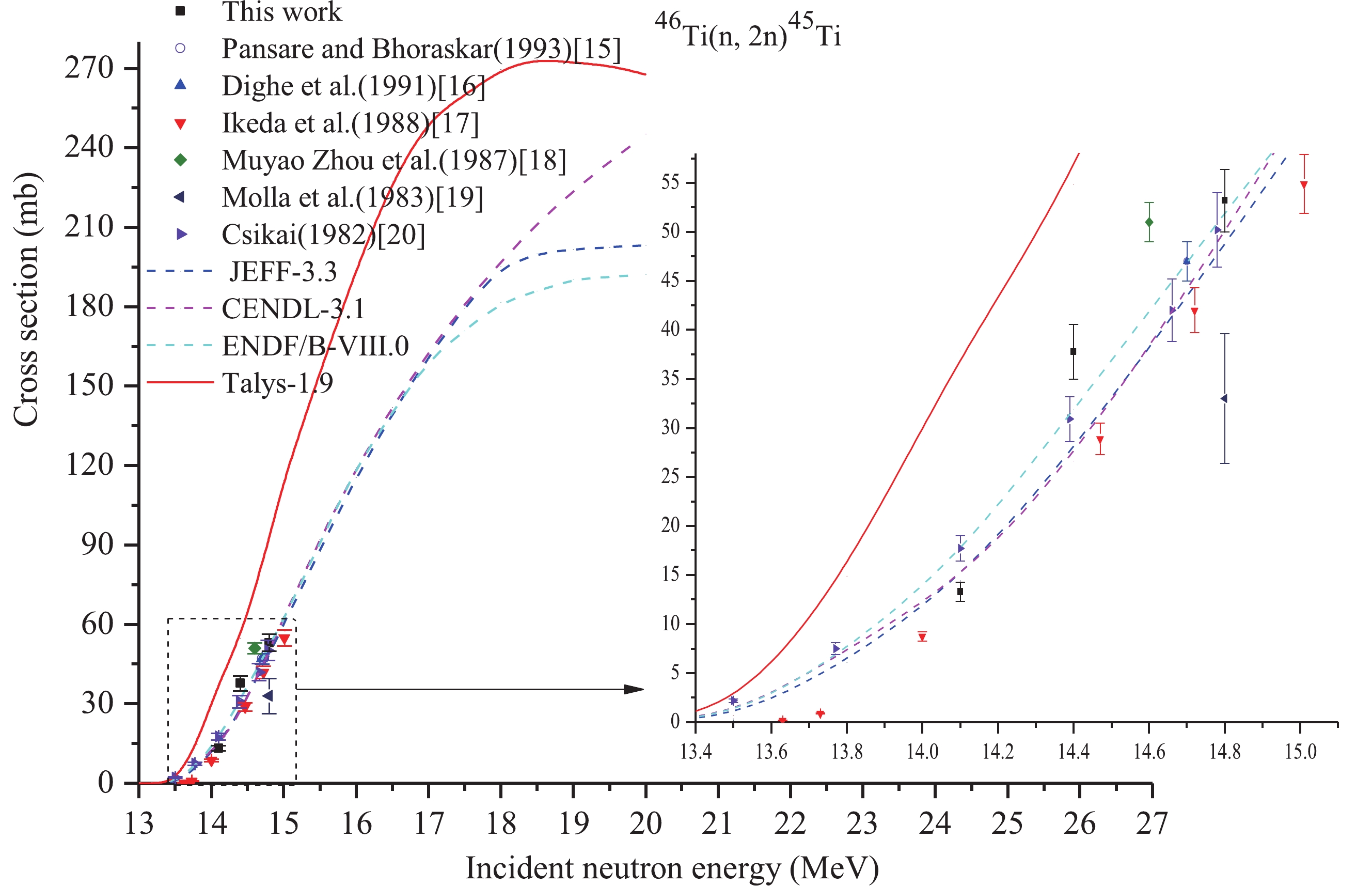
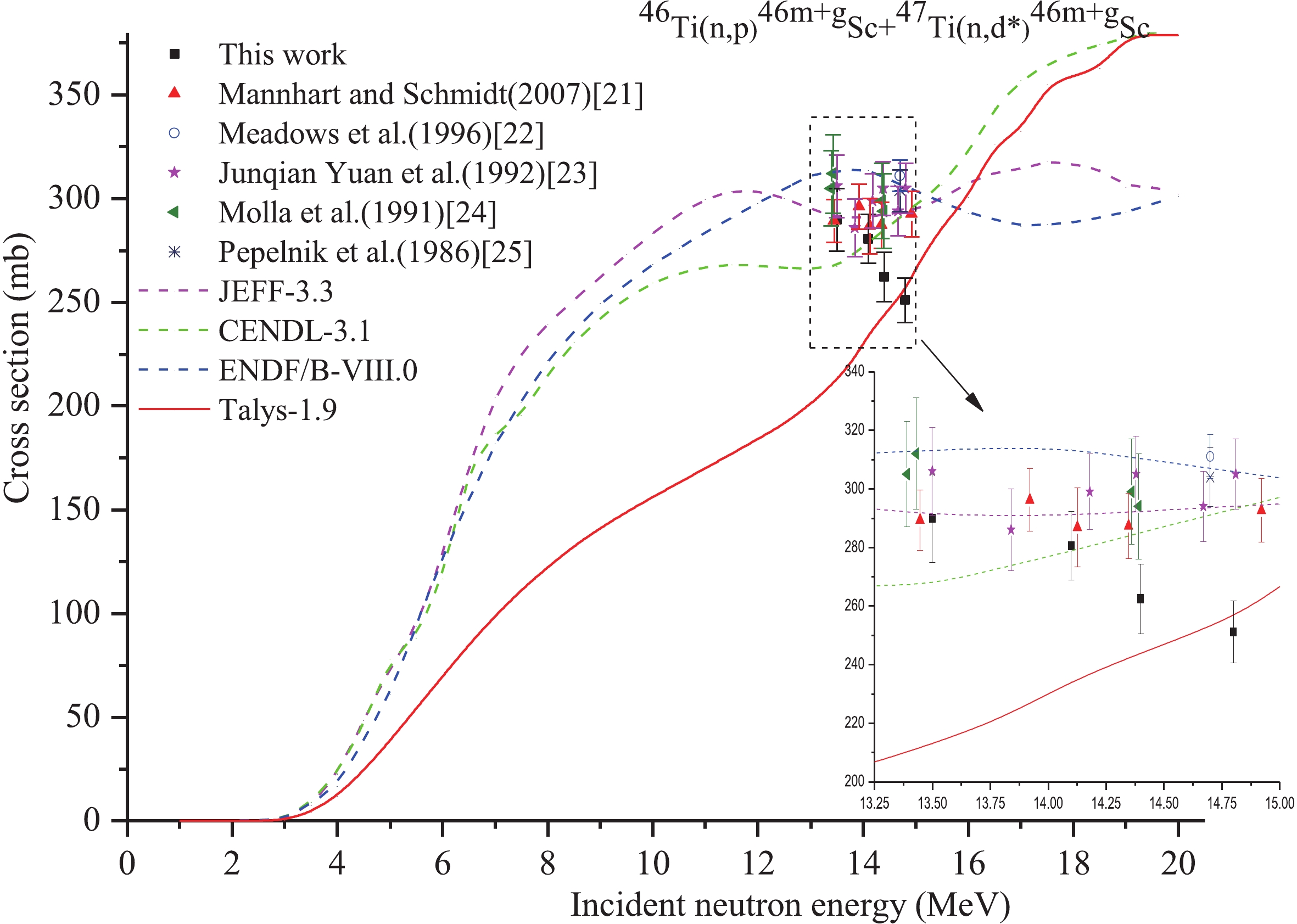
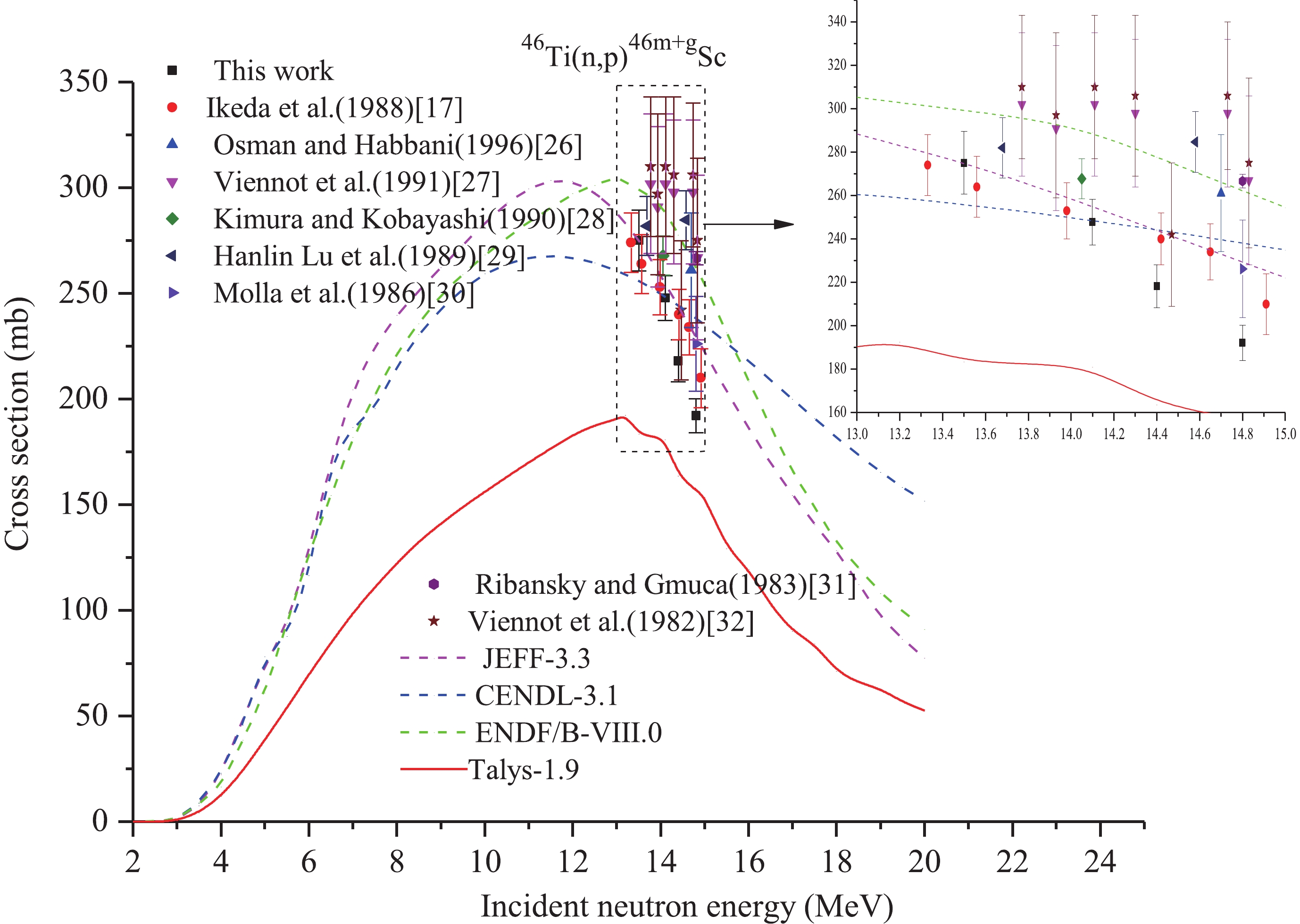

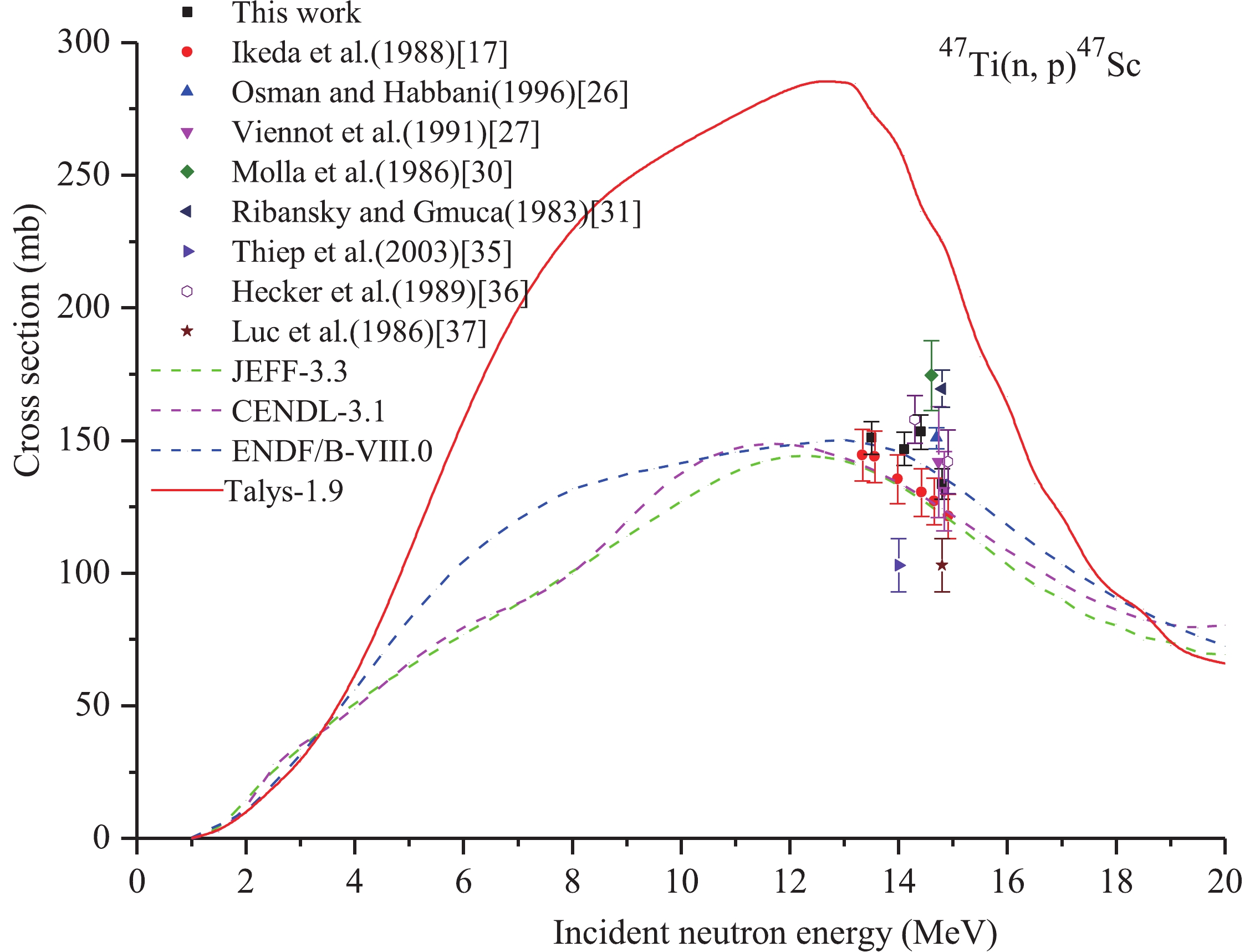
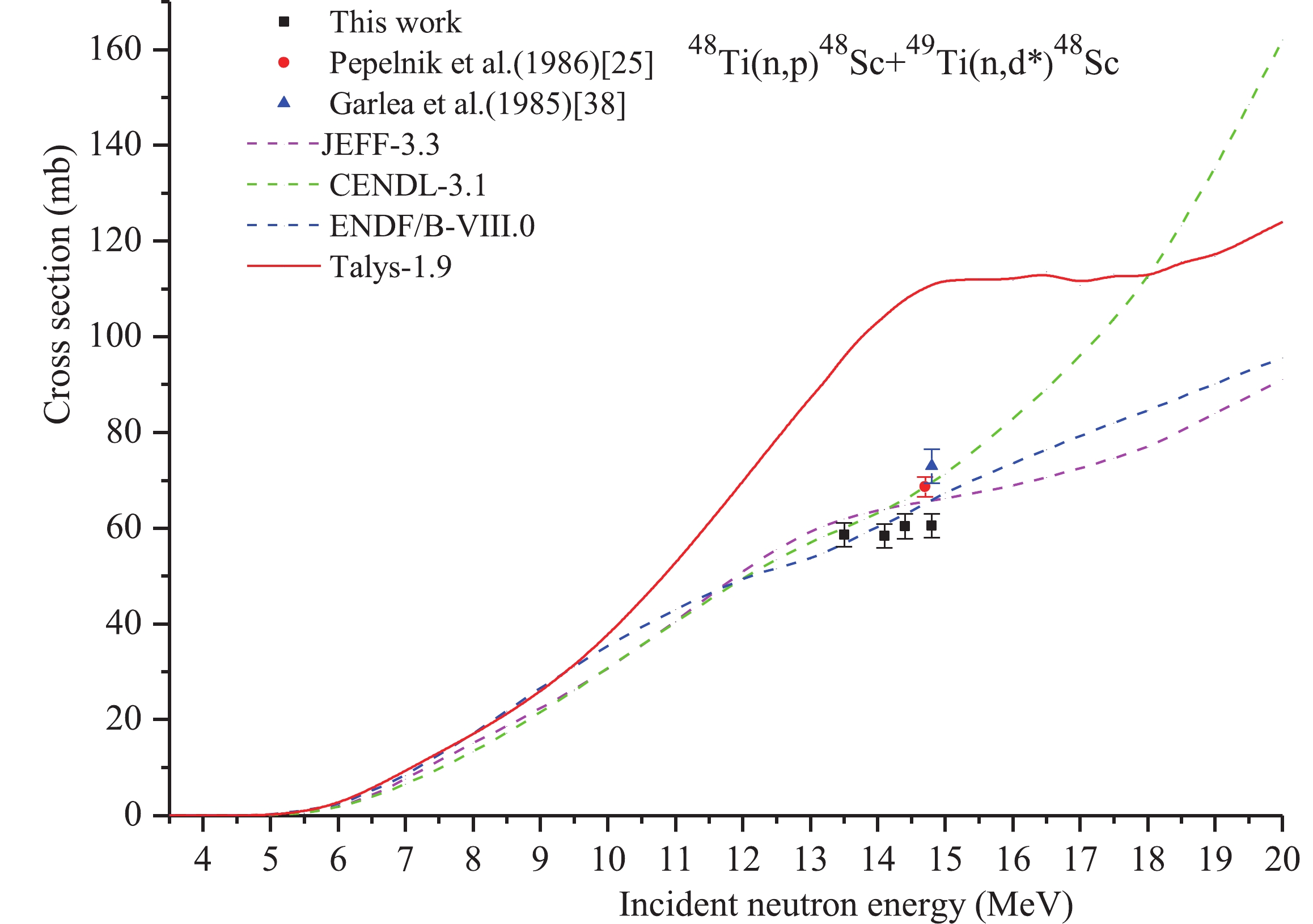
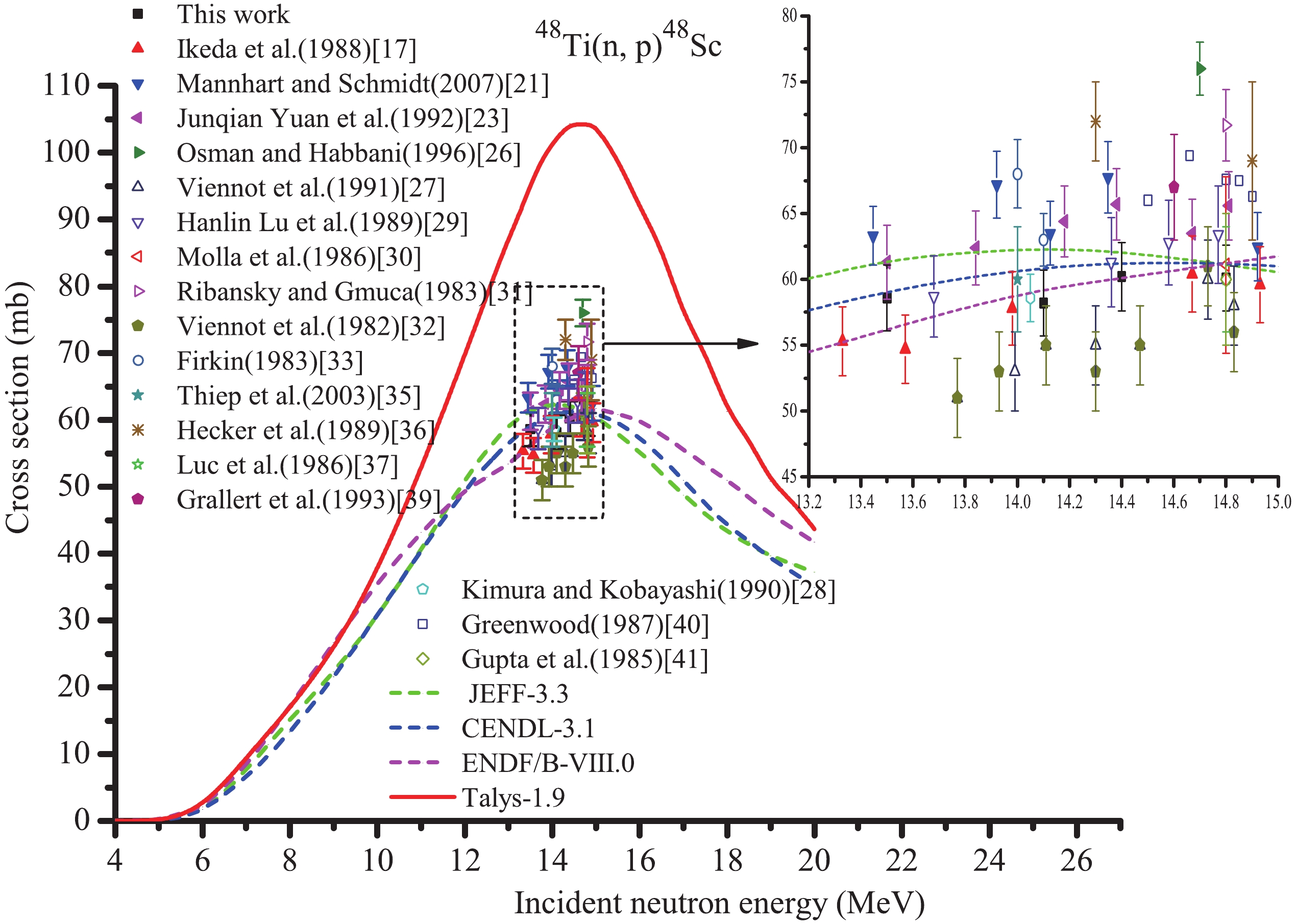




 DownLoad:
DownLoad: